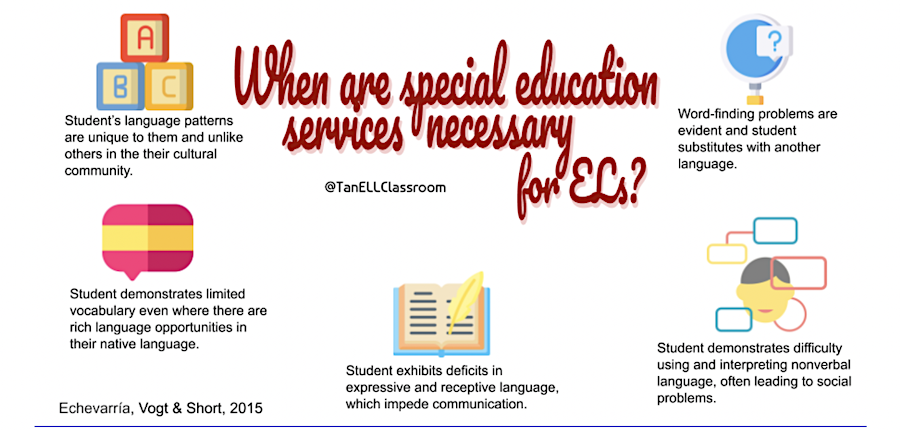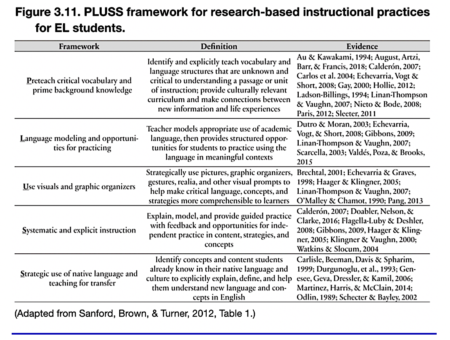When Should We Refer ELs to Special Ed?
A MiddleWeb Blog
This is my sixth article in a year-long writing partnership where Valentina Gonzalez and I attempt to answer some of your questions around EL instruction.
This week, I’ll share thoughts on referring ELs to special education as requested by Julianne.
Referrals to Learning Support
Haas and Brown state that, “It is neither appropriate, nor legally defensible, to place students into special education programs solely because they struggle academically” (p 106, 2019). They suggest that we must first examine our own practices to determine if our instruction is producing the limited achievement and, as a result, is causing ELs to become targeted for superfluous evaluations for special education.
Often, ELs are placed in special education because they are not progressing academically even though they do not have any identifiable learning disorders. However, while slow academic progress is not a reason to place ELs in learning support programs, it is certainly one of many indicators that might trigger an evaluation.
There are many other worthwhile indicators that might suggest ELs would be eligible for learning support services, including (Echevarria et al., 2015):
• Student’s language patterns are unique to them and unlike others in the student’s cultural community.
• Student demonstrates limited vocabulary even where there are rich language opportunities in the native language.
• Student has problems with word-finding and substitutes with another language.
• Student exhibits deficits in expressive and receptive language, which impede communication.
• Student demonstrates difficulty using and interpreting nonverbal language, often leading to social problems.
After working with many dually-identified ELs, I have observed that there are two key indicators of processing issues that usually warrant a referral for special education evaluation.
1. Poor Information Recall
The first indicator of a processing issue is a student’s inability to recall information and details. One student I had struggled to recall facts from a science video. When supporting her in math class, she also struggled to recall details from a word problem. When working with her in social studies class, despite verbally talking her ideas out before writing them down, she had forgotten them as well by the time she needed to write. Her consistent inability to recall details about her assignments across a variety of disciplines indicated that she probably needed an evaluation.
2. Lack of Native Language Vocabulary
The other recurring indicator is the lack of vocabulary in students’ home languages. I once worked with an EL from Vietnam. While he is fluent in Vietnamese, when he tried to describe an object like an airplane, he had to describe the context around it to get to the word. He would say, “The thing that we fly in to get to places far away.” Being able to describe abstract concepts such as faith, wisdom, or identity is understandably difficult for many; however, when a student has difficulty naming even physical objects in their home language, then this is a possible indicator of requiring learning support services.
Additionally, ELs who struggle to retain small chunks of information, find difficulty in applying information to similar contexts, or find tasks that require describing and identifying challenging might have processing issues. Furthermore, students whose home-language proficiency is not comparable to their same-aged peers is another indicator. If several or all of these conditions exist, it would be to the child’s benefit to be referred for special education evaluation.
Supporting Dually-Identified ELs
Haas and Brown write that, “Even if a student is found eligible for special education services, their academic progress will be influenced by the quality of instruction they receive in their general education classes” (p. 29, 2019). Therefore, if we want to support ELs who are dually identified, we must provide them with high quality instruction in both locations.
Some of my favorite strategies to use when working with dually-identified ELs are:
• Establish comprehensible input: Some dually-identified ELs struggle with mental overload. There’s just too much information to manage. They might only be able to retain one unit of information at a time. Therefore, these ELs must understand one detail before going on to another. For example, to understand photosynthesis, ELs must first understand that plants take in different things to live. When dually-identified ELs understand this fact, then we can teach them that one of those things is water (Krashen, 1981).
• Facilitate comprehensible output: Dually-identified ELs can and should engage in highly complex, cognitively challenging tasks. However, they are often so overwhelmed by the task that they do not know where to start. Support them by directing them to start with only one part of the task – preferably the most cognitively accessible one. For example, when creating a stop-motion video, focus on the task of creating the story line. This task is readily understandable and helps set up the direction for the future tasks without getting bogged down in too many technical details.
Haas and Brown suggest using the PLUSS framework to provide high-quality instruction that supports English learners who are dually identified (2019). Describing each element of the PLUSS model is an entirely separate article, though, so we will not go into it in detail here. We did want, however, to give you some tangible starting points of this system in the graphic below.
Be Cautious and Conservative
We have to be extra cautious and conservative when referring ELs to learning support.
An EL’s developing language skills can easily be misdiagnosed as a learning disorder. We must first ask if we are providing ELs with high-quality instruction before we blame a learning disorder for their limited achievement.
If we fail in our due diligence and incorrectly dually identify them, imagine the negative self-perception that we have imprisoned students in. Imagine how this narrative could potentially shape not only their education experience, but also their entire future.
Resources
Echevarría, J., Vogt, M., & Short, D. (2017). Making content comprehensible for English learners: The SIOP Model. Boston: Pearson.
Haas, E., & Brown, J. E. (2019). Supporting English learners in the classroom: Best practices for distinguishing language acquisition from learning disabilities. New York, NY: Teachers College Press.
Hattie, J. (2015). The applicability of Visible Learning to higher education. Scholarship of Teaching and Learning in Psychology, 1(1), 79-91.
Honigsfeld, A., & Dove, M. G. (2019). Collaborating for English learners: A foundational guide to integrated practices. Thousand Oaks, CA: Corwin.
Krashen, S. (1981). Second Language Acquisition and Second Language Learning. Oxford: Pergamon Press.
Sanford, A. K., Brown, J. E., & Turner, M. (2012). Enhancing instruction for English learners in response to intervention systems: The PLUSS model. Multiple Voices for Ethnically Diverse Exceptional Learners, 13(1), 56–70.







































Thank you for addressing the lack of native language in dually identified students. We are seeing more and more students who register for PK with an incredibly low native language. These students will qualify for speech therapy later if we do not intervene now. We try to keep them out of speech because this is monolingual instruction that does not support the native language but replaces it causing even more damage.
Hi, Dan.
Thank you for the comment. Yes, subtracting language instruction does so much damage, not only to language development, but also cultural identity. Thank you for being part of this movement to advocate for language learners who are dually identified.
Thank you! These are very reasonable causes and their explanations! I think it is very important to recognize the individual needs and problems of the students as early as possible and to give them specialized training assistance.
Thanks for reading and taking the time to comment, Camilla. You’re 100%. Time is of the essence when providing dually-identify language learners the services they need.